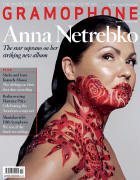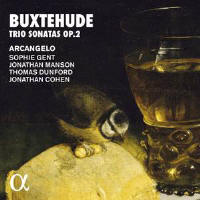Texte paru dans: / Appeared in: |
|
|
Outil de traduction (Très approximatif) |
|
|
Reviewer: Lindsay Kemp For Arcangelo to follow Handel’s Brockes Passion so soon with trio sonatas by Buxtehude is an eloquent demonstration of their flexibility as an ensemble. That the musicians involved are chamber players of the calibre of violinist Sophie Gent, gamba player Jonathan Manson and lutenist Thomas Dunford, with director Jonathan Cohen on harpsichord, is also a testament to the quality that runs through this group. Buxtehude’s Op 2 of 1696 is the second of two publications in which the Lübeck master offered up seven trio sonatas that, instead of pitching together two equalvoiced melody instruments – violins or recorders, say – require a line-up of violin, viola da gamba and continuo. They thus differ from the influential models being set at that time by Corelli, as they do in a looser and more varied construction of connected sections – chaconnes, gigues, quasi-recitatives, fits of Biber-like flashfiddling – that descends from the stylus phantasticus of the earlier 17th century. The way some sections play mechanistically with short, fidgety patterns perhaps reveals the organist’s hand but, though some may go on a little, they usually climax in a warmly satisfying cadence. Arcangelo already produced a good account of Op 1 (A/17), and this followup presents the same virtues while losing many of the few (minor) faults. In particular the balance is a happier one on the new recording, containing Dunford’s naturally exuberant lute-playing within the texture and allowing the gamba a better chance to hold its own. The sound has bloom and tenderness, with Gent’s violin providing a rich shine, and the group as a whole play with sensitivity both to each other and to the music. Sonata No 5, with its strong contrasts and substantial solos, is a tour de force, but elsewhere I liked the way Arcangelo seem simply to enjoy the sound world they are creating, almost in reverie, instead of always having to push at the tempo. Sonata No 7 provides fine examples, especially in its dreamy opening, though later on they also remember to move things on in a sweetly judged siciliana, and in the final section to nudge it into a cultured trot. There are also fine recordings of Op 2 by Ton Koopman and friends (Challenge Classics, 8/12) and the Purcell Quartet (Chandos, 5/12); this one, by a small margin, is perhaps the handsomest. |
|




